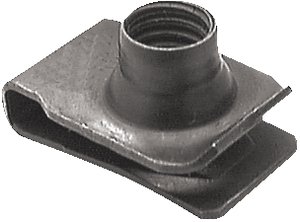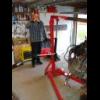
Putting A Threaded Hole In A Fiberglass Panel.
#1

Posted 27 April 2015 - 10:42 PM
But what about a Fiberglass panel.
Why?
Fibreglass doors. Alloy skin. Was held in place by sealant and self tapper screws.
It worked but is not really serviceable.
What have you used and found best? I know there are a few options but.....
#2

Posted 27 April 2015 - 11:20 PM
#3

Posted 27 April 2015 - 11:23 PM
#5

Posted 27 April 2015 - 11:38 PM
Glass nuts? Not heard of them? Got a link?
Ha ha, damn text correction strikes again. What I meant was to fiberglass the nuts in, something like T nuts or speed nuts.
by the way, you get glass nuts as a prothesis
#6

Posted 27 April 2015 - 11:45 PM
I think that could be a verb.
You can cut a thread directly in Grp if it's thick enough. Though it does tend to wear if it's unscrewed regularly. I tend to tap holes and use roofing screws as a stud, but it doesn't sound like it'd suit your application. Aluminium doesn't bond too well with resin, but you could drill some extra holes, for a mechanical joint, and bond a strip in. Then drill your skin and moulding together to tap.
#7

Posted 28 April 2015 - 02:21 AM
Why not Rivnuts? They use them in carbon bicycle frames. How thick is the material?
#8

Posted 28 April 2015 - 02:37 AM
Sticks like sh*t. One time deal though, don't think you could separate them again.
#9

Posted 28 April 2015 - 07:11 AM
you have not see the fiberglass. i am thinking i will need to do some remedial work on them any way so going to have to have a think.Why not Rivnuts? They use them in carbon bicycle frames. How thick is the material?
#10

Posted 28 April 2015 - 07:13 AM
Edit: take that back if the panel is in bad condition
Edited by Coxie, 28 April 2015 - 07:15 AM.
#11

Posted 28 April 2015 - 11:50 AM
There are several options depending on what the requirements are around protrusions/strength etc.
Riv-nuts can be OK in fibreglass panels if they are thick enough not to just splinter as the nut expands. They can also be OK if you get long riv-nuts that go all the way through the GRP and you can add a metal washer behind the panel but below where the nut will expand - effectively the nut expands and squeezes the GRP between it's head and the washer (this is a common way of installing pop-rivets on composite or plastic panels.
You get inserts that are sort of like riv-nuts but with a knurled or splined outer surface that are just designed to be bonded in rather than "set" by expanding them. A slight variation does expand a little as a bolt goes into them sort of like a rawl-plug in masonry.
The predecessor to riv-nuts was a metal plate with a riv-nut type thing welded on and holes around it that are used to pop-rivet it to the parent panel. See above about how to pop-rivet into GRP. These can also be bonded to the rear of a GRP panel to become a sort of captive nut.
Is there anything wrong with a plain old nut-and-bolt?
There are other variations I can think of but would need far more specifics on how the assembly goes together to give an opinion.
Iain
#12

Posted 28 April 2015 - 02:56 PM
nut and bolt. cant get to the nut as the inner door skin will close the hole.Is there anything wrong with a plain old nut-and-bolt?
There are other variations I can think of but would need far more specifics on how the assembly goes together to give an opinion.
Iain
more info see above. IE fixing a side to close a box.
Edited by nicklouse, 28 April 2015 - 02:56 PM.
#13

Posted 28 April 2015 - 03:08 PM
#14

Posted 28 April 2015 - 07:55 PM
At the moment these seem to be a good option

But it does make the positioning defined by the door opening rather than the panel.
Mm I could cut slots for the existing holes.
Or new panels so new holes.....
Edited by nicklouse, 28 April 2015 - 07:56 PM.
#15

Posted 28 April 2015 - 08:19 PM
1 user(s) are reading this topic
0 members, 1 guests, 0 anonymous users

















